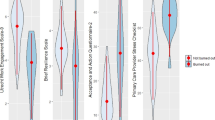Abstract
There are few studies which have investigated variables associated with the development of burnout among residents working with cancer patients. The aim of this study is to identify variables leading to residents’ burnout in order to develop effective interventions. Burnout was assessed with Maslach Burnout Inventory. Person- (i.e., emotional-focused coping) and work-related (i.e., changes in lack of organizational support index) variables explain 28% of the variance in changes in emotional exhaustion. Training programs may be improved by adding specific modules for residents, about problem-focused coping in interviewing patients, and for supervisors, about effective team management.
Similar content being viewed by others
References
Maslach C, Schaufeli WB, Leiter MP (2001) Job burnout. Annu Rev Psychol 52:397–422
Prins JT et al (2007) Burnout in medical residents: a review. Med Educ 41(8):788–800
Hillhouse JJ, Adler CM, Walters DN (2000) A simple model of stress, burnout and symptomatology in medical residents: a longitudinal study. Psychol Health Med 5(1):63–73
Nyssen AS et al (2003) Occupational stress and burnout in anaesthesia. Br J Anaesth 90(3):333–337
Martini S et al (2004) Burnout comparison among residents in different medical specialties. Acad Psychiatry 28(3):240–242
McManus IC, Keeling A, Paice E (2004) Stress, burnout and doctors' attitudes to work are determined by personality and learning style: a twelve year longitudinal study of UK medical graduates. BMC Med 2:29
Dosanjh S, Barnes J, Bhandari M (2001) Barriers to breaking bad news among medical and surgical residents. Medical Education 35(3):197–205
Biaggi P, Peter S, Ulich E (2003) Stressors, emotional exhaustion and aversion to patients in residents and chief residents—what can be done? Swiss Med Wkly 133(23–24):339–346
Sargent MC et al (2004) Stress and coping among orthopaedic surgery residents and faculty. J Bone Joint Surg Am 86-A(7):1579–1586
Maslach C, Jackson A, Leiter MP (1986) Maslach Burnout inventory manual. Consulting Psychologists, Palo Alto
Goldberg DP, Hillier VF (1979) A scaled version of the general health questionnaire. Psychol Med 9:139–145
Spielberger CD, Gorusch RR, Lushene RE (1983) State-trait anxiety inventory test manual. PACP
Rotter JB (1966) Generalized expectancies for internal versus external control of reinforcement. Psychol Monogr 80(1):1–28
de Boer AG et al (2004) Is a single-item visual analogue scale as valid, reliable and responsive as multi-item scales in measuring quality of life? Qual Life Res 13(2):311–320
Parle M, Maguire P, Heaven C (1997) The development of a training model to improve health professionals’ skills, self-efficacy and outcome expectancies when communicating with cancer patients. Soc Sci Med 44(2):231–240
Vitaliano PP et al (1985) The ways of coping checklist: revision and psychometric properties. Multivariate Behav Res 20:3–26
Booth K, Maguire P (1991) Development of a rating system to assess interaction between cancer patients and health professionals. Cancer Research Campaign, London
Spielberger CD, Reheiser EC (1994) The job stress survey—measuring gender differences in occupational stress. J Soc Behav Pers 9(2):199–218
Martel JP, Dupuis G (2006) Quality of work life: theoretical and methodological problems, and presentation of a new model and measuring. Soc Indic Res 77:333–368
Rafferty JP et al (1986) Validity of the Maslach Burnout inventory for family practice physicians. J Clin Psychol 42(3):488–492
Maslach C (1982) Burnout: the cost of caring. Prentice-Hall, Englewood Cliffs
Narumoto J et al (2008) Relationships among burnout, coping style and personality: study of Japanese professional caregivers for elderly. Psychiatry Clin Neurosci 62(2):174–176
Karasek RA (1979) Job demands, job decision latitude, and mental strain: implications for job redesign. Adm Sci Q 24(2):285–308
Siegrist J (1996) Adverse health effects of high-effort/low-reward conditions. J Occup Health Psychol 1(1):27–41
Bakker AB, Demerouti E (2007) The job demands-resources model: state of the art. J Manag Psychol 22(3):309–328
Adam S, Gyorffy Z, Susanszky E (2008) Physician burnout in Hungary: a potential role for work-family conflict. J Health Psychol 13(7):847–856
Costa TPJ, McCrae RR (1989) The NEO-PI/NEO-FFI manual supplement. Psychological Assessment Resources, Odessa
Geurts SAE (2000) SWING: survey work-home interaction Nijmegen (internal research report). University of Nijmegen, Nijmegen,the Netherlands
Leiter MP, Maslach C (1988) The impact of interpersonal environment on burnout and organizational commitment. J Organ Behav 9:297–308
Author information
Authors and Affiliations
Corresponding author
Additional information
Supported by the Fonds National de la Recherche Scientifique—Section Télévie of Belgium and by the C.A.M., training and research group (Brussels, Belgium).
Rights and permissions
About this article
Cite this article
Bragard, I., Etienne, AM., Libert, Y. et al. Predictors and Correlates of Burnout in Residents Working With Cancer Patients. J Canc Educ 25, 120–126 (2010). https://doi.org/10.1007/s13187-010-0050-9
Received:
Accepted:
Published:
Issue Date:
DOI: https://doi.org/10.1007/s13187-010-0050-9



